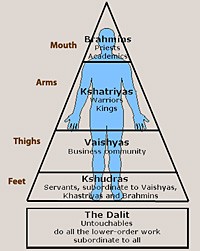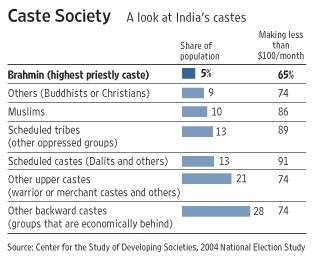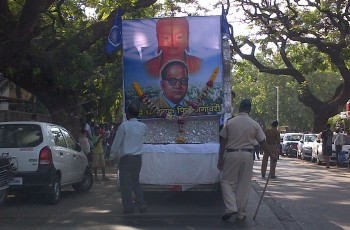10/22/2013
Why in India there is a caste system?
After 7 years in India, I obviously wrote quite a bit on the subject (see below). I have sometimes been revolted against this system. I have accepted it. Ignored it. Forgotten it.
It is not so much this system – let us be realistic, every society is divided in social classes – but its rigidity that disturbs so much… Your caste (which you are born in) defines what you will do, eat, marry etc.
I have never really searched where this system comes from… 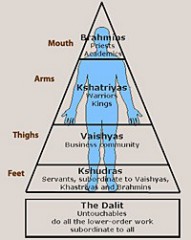
According to ancient Hindu books, human society was created from a body: the Brahmins would come from the head, the Kshatriyas from the hand, the Vaishias from the thighs and the Sudras from the feet. In some versions, the original body would be of a primeval giant, Purusha, sacrificed by the gods to create a human society; in others it would be Brahma.
All animated and inanimated things are believed to possess three qualities, in different proportions: Sattva, Rajas and Tamas. Brahmins would be loaded with Sattva qualities (which include wisdom, intelligence, honesty, goodness and other positive qualities); Kshatriyas and Vaishias with Rajas qualities (passion, pride, valour and other passionate qualities); Sudras with Tamas qualities (dullness, stupidity, lack of creativity and other negative qualities). Hence the different occupations that each people would occupy. And the different diets and different dosages of food they would need to develop their inherent qualities. For instance meat is considered Tamasic food but also Rajasic.
It seems likely to me that these two explanations were developed to support a system with social-historic roots. Which brings us back somewhere around 2000 years BC when the Harappan civilization of the Indus Valley started to decline and the Aryans (Indo-European speakers from Central Asia), a group of warrior nomads began to migrate. There is no agreement between scholars whether “the Aryans and Harappans mixed together and became peaceful, or the Aryans came in as a conquering people, became the ruling class, and instituted the caste system to maintain control”.
However, and this is my personal observation, the stratification of the society in India is clearly linked to the skin colour. The fairer the higher in caste, the smarter, the richer, the more beautiful. At least it is perceived like this. And it’s no new thing. One should see how a baby can stare at a white person. And I have met very few Indians who don’t have, somewhere, an inferiority – totally unjustified and difficult to understand for me – complex toward white skinned. And I don’t think it can only be the result of the British colonisation… Just read old Hindu religious stories: “there are many wars between the good Aryans and the dark skinned demons and devils”.
Somehow the organisation of the Aryans in three groups (the Rajayana which became the Kshatrias (warriors), the Brahmins (priests) and the Vaisias (farmers and craftsmen) , which is pretty logical and easy to adopt, spread on to the local society. Later on, “communities who professed non-polluting jobs were integrated in Sudra Varna and communities who professed polluting professions were made outcasts”.
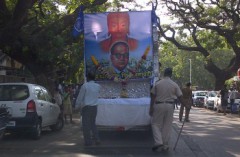 So it was convenient for the rules to keep the system that way – as it would be for any ruler in any society. Rules were strict and abided by. Religion (as Hinduism is mostly a canvas of superstitions) was also used to keep everyone on the right track in fear of retaliation. And what makes India different from other countries is that people don’t really rebel against the order of things, and neither does religion decline. They do at times – see how the Untouchable Ambedkar encouraged Hindus to convert to Buddhism in reaction to the caste system, and how such conversions of dalits still happen nowadays, for instance for the 50th anniversary of the leaders’s death* – but fundamentally the society remains the same…
So it was convenient for the rules to keep the system that way – as it would be for any ruler in any society. Rules were strict and abided by. Religion (as Hinduism is mostly a canvas of superstitions) was also used to keep everyone on the right track in fear of retaliation. And what makes India different from other countries is that people don’t really rebel against the order of things, and neither does religion decline. They do at times – see how the Untouchable Ambedkar encouraged Hindus to convert to Buddhism in reaction to the caste system, and how such conversions of dalits still happen nowadays, for instance for the 50th anniversary of the leaders’s death* – but fundamentally the society remains the same…
Is the caste system still present and visible in cities?
“Either it doesn’t really prevails in my world (personal and professional), either it is too subtle for me – at the same time I don’t really dig”.
However read my story of the fat superior Indian giving a lesson to a waiter:
(24/04/2013)
Do Indian people rebel against this system?
“In the countryside, the caste system prevails.
Read the story of Sampat Pal, a shepherdess who, with her Pink Sari gang, rebelled against the injustices inflicted to lower castes by higher castes or to women by men, against corruption and stealing of subsidised food, lands, jobs which the Government reserves for the poorest.”
(20/04/2013)
The issue of castes and quotas in today’s society
“The Indian Constitution prohibits discrimination based on caste.
That said it does not belong to the Government to abolish such a system because it is related to religion. As a matter of fact, the last census (2011) included a (optional) question about the caste.
Casteism is a pillar of Hinduism: "the fulfilment of one personal duty to the caste - and not a universal duty - and the system of reincarnation in a higher or lower caste as a reward for your good or bad actions are the two fundamental pillars of this religion until the final liberation and paradise.")
To fight this discrimination, the Government has implemented quotas for access to education, civil servant positions, political seats. There even has been an untouchable president (K. R. Narayanan).
The problem is that today it is all mixed up and ultimately these quotas are based on the social status (caste) of people but not on the merit or the income. And as low and out-castes form a majority, politicians are struggling to change this system...”
www.indiandacoit.com/archive/2013/04/22/about-casts-and-inequalities-in-india-the-big-picture.html
22/04/2013
What about the lower castes and outcastes? And how do Westerners see it?
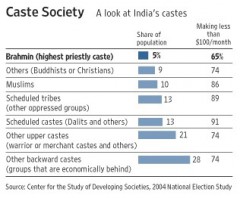 In India people referred to other compatriots as “uneducated” all the time. A term a bit shocking to a French. As the word “backward” to refer to a class of people in the lower castes.
In India people referred to other compatriots as “uneducated” all the time. A term a bit shocking to a French. As the word “backward” to refer to a class of people in the lower castes.
“According to the last census (source: http://www.censusindia.gov.in/2011census) « Intouchables » and the tribes represent 30% of the Hindu population / 24% of the Indian population. And if you add the ‘feet’ (kshudras or lower castes) you get 54% of the population.”
http://www.indiandacoit.com/archive/2011/04/14/and-you-what-s-your-little-name.html#more 04/05/2011
Marc Boulet wrote “In the skin of an Intouchable” – he basically learned Hindi perfectly, took drugs to get a tan and lived on the street as an Intouchable beggar for months…
“Westerners completely fall for it. They rightly fight racism and anti-Semitism but they see the caste system with a lot of indulgence and consider that it is part of the Indian cultural heritage, like the Tâj Mahal. They don’t get shocked, outraged, by the caste system; it is far away. And I also think that their benevolence comes from the fact they admire the brahman civilisation and they get disgusted by sweepers and other untouchables, altogether with beggars and lepers for whom they only think of a contemptuous charity. […] I am not scared of words anymore. The caste system is a segregationist system, just as Apartheid in South Africa. As revolting, as condemnable.”
http://www.indiandacoit.com/archive/2011/05/04/untouchables-again.html
14/04/2011
http://adaniel.tripod.com/origin.htm
http://www.thenagain.info/webchron/india/AryanMig.html
http://www.ambedkar.org/Babasaheb/Why.htm
08:00 Posted in Why in India... | Permalink | Comments (0) | Tags: india, ambedkar, caste, castes, cast system, religion, society, census, lower castes, outcasts, pink sari gang, backward, marc boulet, casteism, hinduism, sattva, rajas, tamas, aryans, fair, skin complexion, white | ![]() Facebook | |
Facebook | |
04/22/2013
About casts and inequalities in India - The big picture
The system of the castes in India dates back thousands of years. Hyper complicated but also quite simple in substance.
There are 4 varnas or “families” of castes (the most famous being the upper caste of the “Brahmins”) and then the out-caste known as “untouchables” and today called "scheduled class”. The varnas, representing the 4 parts of the God Brahma’s body (see diagram), are divided into thousands of castes, called jatis, which each have a specific role (more or less a profession).
Every Hindu is born into a caste, shares its culinary habits, gets married within, and died within, hoping to get reborn in a higher caste. And people don't mix. Everyone at their place and the sheep will be well kept as we say in French...
The Indian Constitution prohibits discrimination based on caste.
That said it does not belong to the Government to abolish such a system because it is related to religion. As a matter of fact, the last census (2011) included a (optional) question about the caste.
Casteism is a pillar of Hinduism: "the fulfilment of one personal duty to the caste - and not a universal duty - and the system of reincarnation in a higher or lower caste as a reward for your good or bad actions are the two fundamental pillars of this religion until the final liberation and paradise."*). To the point that Dr. Ambedkar encouraged untouchables to convert to Buddhism in the 1950s.
To fight this discrimination, the Government has implemented quotas for access to education, civil servant positions, political seats. There even has been an untouchable president (K. R. Narayanan).
The problem is that today it is all mixed up and ultimately these quotas are based on the social status (caste) of people but not on the merit or the income. And as low and out-castes form a majority *, politicians are struggling to change this system...
Besides, in the countryside, where 70% of the population still live, the caste system is still very much alive and rigid.
As Sampat Pal says*, " India has been a free and independent country for sixty years: yet the poorest people still don’t know what it is to live in an independent country. Laws are modern, but because of an administration rife with corruption, they are not applied. In sixty years, they have brought neither social justice nor improvement in the standard of living for the poor. Their daily life has not changed one bit." As I hardly go to the country side I can’t really comment on this but every day we can read stories of girls severely injured by their own gang and/or family for having wanted to marry a man of a different caste...
* In the shoes of an untouchable, Marc Boulet
* According to the latest census (source: http://www.censusindia.gov.in/2011census) the “untouchables” and tribes account for 30% of the Hindu population / 24% of the Indian population. And if we add the "feet" (the “kshudras” or lower castes) it gives us 54% of the population.
* I, Sampat Pal, head of the pink sari gang, Sampat Pal
To be continued in the next post…
08:02 Posted in Incredible India! | Permalink | Comments (0) | Tags: india, castes, casts, caste, system, untouchability, intouchables, pariahs, pink sari gang, sampat pal, ambedkar, inequalities, poverty, discrimination | ![]() Facebook | |
Facebook | |
04/20/2013
About casts and inequalities in India - The pink sari gang
It is funny: I had just finished a book about poverty and inequalities in India, when my (foreign) colleagues started asking me tons of questions about untouchability and the moment I got back in India, I got stuck in many parades of untouchables...
A parade with cars blasting music and displaying pictures of Ambedkar and Buddha (explanation in the next post)
First, I’d like to talk about the book. It is written in French and called I, Sampat Pal, head of the pink sari gang by Sampat Pal and Anne Berthold (2008).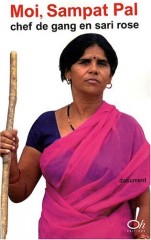
This is the incredible story of a small shepherdess who skipped field work without authorisation to attend school at a time when girls had no access to education. And then the little shepherdess with a very strong personality grew up and began to learn to sew. She became self-sufficient, independent and even starting sewing to other people. She discovered that one can change things – which is far from being obvious in India, since the caste system is inseparable of an unquestioned sense of the order of things.
She rebelled against the injustices inflicted to lower castes by higher castes or to women by men, against corruption and stealing of subsidised food, lands, jobs which the Government reserves for the poorest.
Most notably she realized that fighting together is the only way to be heard and she gathered thousands of women: the gang of the pink sari (their website: here).
An uplifting read!
To be continued in the next post…
08:00 Posted in Incredible India! | Permalink | Comments (0) | Tags: india, castes, casts, caste, system, untouchability, intouchables, pariahs, pink sari gang, sampat pal, ambedkar, inequalities, poverty, discrimination | ![]() Facebook | |
Facebook | |















